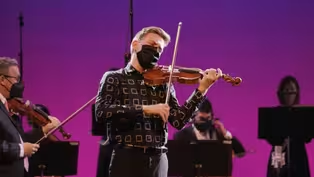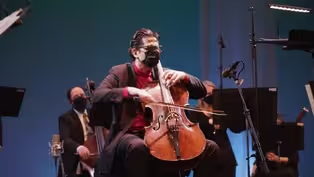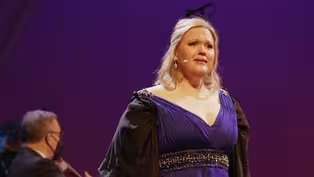
Depths of the Piano | Asheville Symphony
11/1/2022 | 56m 50sVideo has Closed Captions
Pianist Adam Golka celebrates piano concertos written by virtuosos, for virtuosos.
Award-winning pianist Adam Golka celebrates piano concertos written by virtuosos, for virtuosos. Explore the delicate balance and tension between orchestral forces and the piano through a selection of some of the most famous works written for piano and orchestra.
Problems playing video? | Closed Captioning Feedback
Problems playing video? | Closed Captioning Feedback
PBS North Carolina Presents is a local public television program presented by PBS NC

Depths of the Piano | Asheville Symphony
11/1/2022 | 56m 50sVideo has Closed Captions
Award-winning pianist Adam Golka celebrates piano concertos written by virtuosos, for virtuosos. Explore the delicate balance and tension between orchestral forces and the piano through a selection of some of the most famous works written for piano and orchestra.
Problems playing video? | Closed Captioning Feedback
How to Watch PBS North Carolina Presents
PBS North Carolina Presents is available to stream on pbs.org and the free PBS App, available on iPhone, Apple TV, Android TV, Android smartphones, Amazon Fire TV, Amazon Fire Tablet, Roku, Samsung Smart TV, and Vizio.
Providing Support for PBS.org
Learn Moreabout PBS online sponsorshipMore from This Collection
The Violin Journey | Asheville Symphony
Video has Closed Captions
Virtuoso James Thompson explores the versatility of the violin. (56m 50s)
Cello Cantabile | Asheville Symphony
Video has Closed Captions
Israeli cellist Amit Peled presents the full range of the beloved instrument. (56m 50s)
Love According to Mozart | Asheville Symphony
Video has Closed Captions
Mozart’s best arias and duets with soprano Christina Pier and baritone Corey McKern. (56m 50s)
Providing Support for PBS.org
Learn Moreabout PBS online sponsorship[upbeat music] - [Narrator] Funding for Depths of the Piano provided by Deerfield, Gillespie Dental Associates, Frugal Framer, Mercy Urgent Care, Laborde Eye Group, Blackbird Frame & Art, Gould Killian CPA Group, Tops for Shoes, HomeTrust Bank, Groce Funeral Home, Asheville Eye Associates.
[calming orchestral music] ♪ - Hello and welcome.
My name is Darko Butorac.
I'm the Music Director and Conductor of your Asheville Symphony.
Tonight we're gonna go on a journey through the wonderful piano repertoire as we welcome pianist, Adam Golka.
Music from Bach, all the way up to the great romantic concertos of Requiem by Saint-Saens.
Thank you again and enjoy the performance.
[audience applauding] [upbeat orchestral music] ♪ ♪ ♪ ♪ ♪ ♪ ♪ ♪ [audience applauding] Thank you.
Hello and welcome back.
Our guest this evening is Polish American pianist, Adam Golka.
Adam, welcome to Asheville.
- So great to be here, thanks Darko.
- Always a pleasure to work with you.
We had some wonderful concerts in the past, and here we present something entirely different now.
- Yeah, a program of so many different styles and hats to wear.
It's been really exciting putting it together.
- It was.
So this evening we began in the first set.
We present Bach's D Minor Concerto and Mozart's 2nd Movement from his Elvira Madigan Concerto No 21.
Why are these pieces the ones you chose to start the program?
- Well, we were thinking about different styles, and to me, the D Minor Bach Concerto, particularly the 1st Movement, is sort of the great movement, the great fast movement, I would say, of his keyboard concertos, of course, for harpsichord and strings, we're doing with piano, and also very happily for me with conductor, because originally they were played without conductor, but it has a component of so much more vibrancy and interpretation from my view, playing it with you.
So I love doing it this way.
- Yeah, it's one thing for the audience to realize when we work with music of Bach, and earlier composers, they wrote this music for people.
They knew Bach would probably play the part himself, and the musicians in the orchestra were close friends.
So there was no need to notate expression or shape.
It was assumed that if you were a good musician and knew the style, you would simply do it.
And so when we look at this performance, really, it's approaching the score and making choices kind of from your heart of how this music should go, how it should fit together.
And I love the interaction that you bring together there.
It really feels for me like a back and forth in the performance.
What about the Mozart?
- Yeah well, the Mozart, I mean, that's one of the greatest slow movements of any piece, really, I think.
Already the first 22 measures of orchestra is just, it's like heaven sitting there on the piano bench waiting, and it's a very familiar melody, but I think what makes it more than most Mozart movements is that there are these very strange measures of darkness and dissonance that happen three times in the movement.
- [Darko] Yes.
- That are really true goosebump moments.
And I think that in context of that movement, it's what makes it not just beautiful music but really transcendent music.
- That's beautiful.
I love how you described it, I feel exactly the same way.
[audience applauding] [dramatic orchestral music] ♪ ♪ ♪ ♪ ♪ ♪ ♪ ♪ ♪ ♪ ♪ ♪ ♪ ♪ ♪ [audience applauding] [calming orchestral music] ♪ ♪ ♪ ♪ ♪ ♪ ♪ ♪ ♪ ♪ ♪ ♪ ♪ [audience applauding] So now for the second part of our concert, we're gonna change things up quite a bit and move to a far more intimate environment.
The piano was an instrument that really changed music because it allowed music to be brought into the home.
And the 18th, and especially the 19th century saw an explosion of chamber music-making, of solo playing on piano by people throughout the Western world.
And so we thought it would be appropriate to bring some of that element into this concert.
So you chose to begin with Beethoven's Sonata, known as Les Adieux, The Farewell.
- Right.
So I thought that would be a really appropriate composition to play because it's the only Piano Sonata where Beethoven added titles to the movements.
And the 2nd and 3rd Movements are titled Absence and Then the Return.
So it just felt like the right thing, as things are picking up and the optimism is coming back.
And the historical context for that piece is the invasion by Napoleon of Vienna, the second invasion in 1809.
And it was written for the Archduke Rudolf, who was Beethoven's patron.
And Archduke Rudolf had to leave and come back.
So this idea of something disappearing, and the isolation of the 2nd Movement, followed by the overwhelming joy and buoyancy of the 3rd, just felt like the right thing to play.
[piano music] ♪ ♪ ♪ ♪ ♪ ♪ ♪ ♪ ♪ ♪ ♪ ♪ ♪ ♪ ♪ ♪ ♪ ♪ ♪ [audience applauding] - For our final two pieces this evening, we have the beautiful 2nd Movement of Rachmaninoff Piano Concerto No 2, followed by Musical Fireworks from Saint-Saens, his finale from his 2nd Piano Concerto.
So tell us a little bit why we have these in the program.
- So the 2nd Movement of Rachmaninoff's 2nd, I mean, it's for me, one of the most beloved pieces to play and listen to.
- Just beautiful writing for the orchestra, beautiful solos.
Clarinet is featured quite a bit, the string writing is incredibly large.
The harmonies are incredible, and quite a turbulent emotional ride in the piece, right?
It begins very, slowly gets built up.
I don't know, it's the perfect 2nd Movement.
I'm so glad you included it.
And then to finish the concert, something entirely different.
- Saint-Saens' 2, The Presto.
I think a critic described the piece at its premiere as being a piece that starts like Bach, the 1st Movement, which we're not playing, and then ends like Offenbach.
So we're really playing kind of the Offenbach part.
But yeah, I mean, it's a Tarantella of sorts.
It's fantastic, for piano, I mean, just it's so much finesse and virtuosity, and Saint-Saens was, of course, a master pianist who came from a very different world of piano playing.
I listened to a report by Arthur Rubenstein who attended Saint-Saens' concert, and apparently he would comment about how wonderfully he played a phrase out loud during the concert.
Say, oh, that was beautiful, oh.
So you can imagine his sense of humor, you know?
- [Darko] Oh, I'm so good.
- Yeah correct, out loud, so.
- [Darko] Wow, that was a different world.
We've changed quite a bit.
[calming orchestral music] ♪ ♪ ♪ ♪ ♪ ♪ ♪ ♪ ♪ ♪ ♪ ♪ ♪ ♪ ♪ ♪ ♪ ♪ ♪ ♪ ♪ ♪ ♪ ♪ [audience applauding] [dramatic orchestral music] ♪ ♪ ♪ ♪ ♪ ♪ ♪ ♪ ♪ ♪ ♪ ♪ ♪ [audience applauding] [calming piano music] ♪ ♪ - [Narrator] Depths of the Piano was created in partnership with Wortham Center for the Performing Arts, Kimpton Hotel Arras Asheville, North Carolina Arts Council, Explore Asheville, The Payne Fund, Mr. and Mrs. Thomas C. Bolton, University of North Carolina Asheville, Asheville Symphony Guild, Asheville Symphony Symphonettes.
Support for PBS provided by:
PBS North Carolina Presents is a local public television program presented by PBS NC
















